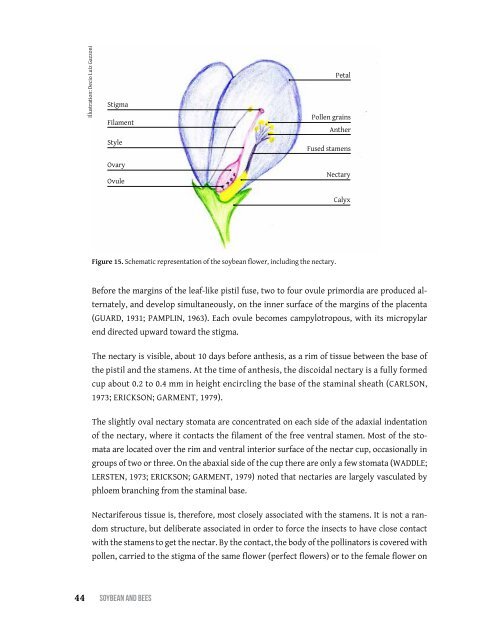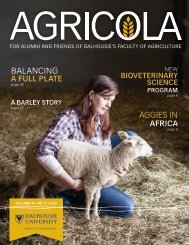SOYBEAN and BEES
BFhV4z
BFhV4z
Create successful ePaper yourself
Turn your PDF publications into a flip-book with our unique Google optimized e-Paper software.
Illustration: Decio Luiz Gazzoni<br />
Stigma<br />
Filament<br />
Style<br />
Petal<br />
Pollen grains<br />
Anther<br />
Fused stamens<br />
Ovary<br />
Ovule<br />
Nectary<br />
Calyx<br />
Figure 15. Schematic representation of the soybean flower, including the nectary.<br />
Before the margins of the leaf-like pistil fuse, two to four ovule primordia are produced alternately,<br />
<strong>and</strong> develop simultaneously, on the inner surface of the margins of the placenta<br />
(Guard, 1931; Pamplin, 1963). Each ovule becomes campylotropous, with its micropylar<br />
end directed upward toward the stigma.<br />
The nectary is visible, about 10 days before anthesis, as a rim of tissue between the base of<br />
the pistil <strong>and</strong> the stamens. At the time of anthesis, the discoidal nectary is a fully formed<br />
cup about 0.2 to 0.4 mm in height encircling the base of the staminal sheath (Carlson,<br />
1973; Erickson; Garment, 1979).<br />
The slightly oval nectary stomata are concentrated on each side of the adaxial indentation<br />
of the nectary, where it contacts the filament of the free ventral stamen. Most of the stomata<br />
are located over the rim <strong>and</strong> ventral interior surface of the nectar cup, occasionally in<br />
groups of two or three. On the abaxial side of the cup there are only a few stomata (Waddle;<br />
Lersten, 1973; Erickson; Garment, 1979) noted that nectaries are largely vasculated by<br />
phloem branching from the staminal base.<br />
Nectariferous tissue is, therefore, most closely associated with the stamens. It is not a r<strong>and</strong>om<br />
structure, but deliberate associated in order to force the insects to have close contact<br />
with the stamens to get the nectar. By the contact, the body of the pollinators is covered with<br />
pollen, carried to the stigma of the same flower (perfect flowers) or to the female flower on<br />
44 SoybeAn <strong>and</strong> bees






